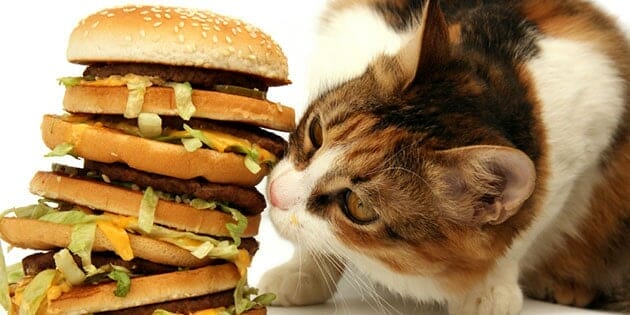This post will arm you with the information you need to feed your cat for optimal health.
The impact that diet has on a cat’s health is dramatic, and proper nutrition is essential for a long life.
The number one thing you need to know about cat nutrition is that cats are obligate carnivores – that means their intestinal tract is designed to eat meat, period.
Cats require animal-based protein, not plant-based protein (grains/peas/potatoes).
With that said – let’s talk about canned foods versus dry foods.
Canned foods are:
high in protein
high in water content
highly tasty to most cats
You already know that cats are obligate carnivores, so the higher protein content in canned foods is essential to your cat’s nutrition. Did you know though, that cats have an instinctively low thirst drive, which means they don’t drink a lot of water.
Unfortunately, this low water consumption may lead to urinary tract disease and kidney problems as they age.
So the high water content in the canned foods is beneficial to ensure your cat gets enough water everyday.
Taste is important to your cat – if it doesn’t taste good cats won’t eat it. Don’t try to outlast your cat on this one – 3 days or more without eating can lead to a serious disease called Hepatic Lipidosis.
Dry foods are:
high in carbohydrates
low in water content
cause carbohydrate “addicts” with their taste being derived from the grains/peas/potatoes, etc.
Carbohydrates often lead to obesity in cats.
Obesity in cats is directly linked to diabetes.
Carbohydrates have been linked to inflammatory bowel disease, other intestinal issues such as vomiting and diarrhea, allergies and asthma.
The low water content aggravates an already low water intake.
Carbohydrate “addicts” are prone to feline lower urinary tract disease, diabetes, obesity, kidney disease, and a myriad of intestinal disorders.
Let’s clear up two myths I hear frequently regarding the canned food versus dry food issue.
Dental disease is worse with canned food: Dry food does not promote better dental health – cats typically swallow their food whole (as they would do in the wild when eating their prey) and the small pieces of kibble are not strong enough to act like a toothbrush against their teeth.
Grain-free means low carb: to manufacture a dry food there must be a grain or starch to hold the food together.
Replacing the wheat/corn with peas, tapioca or potatoes does not lower the carbohydrate content.
In a natural setting, your cat would eat a high protein, high-water-content, moderate amount of fat and less than 2% carbohydrate diet.
What would that diet be? Rodents, lizards, birds, and rabbits – all meat based proteins.
Be aware that the average dry food contains 40-50% carbohydrates!
If you would like the formulas I use to determine protein and carbohydrate content in pet foods, please Contact Me.
Your cat’s health is built on their diet, and if you are going to change from a dry food to a canned food I highly recommend you do this while your cat is healthy.
Carbohydrate “addicts” can be difficult to transition to canned food, and you certainly don’t want to do this when your cat is not feeling well.
If you have a carb “addict” then plan on making the change slowly, possible over 2-3 MONTHS.

